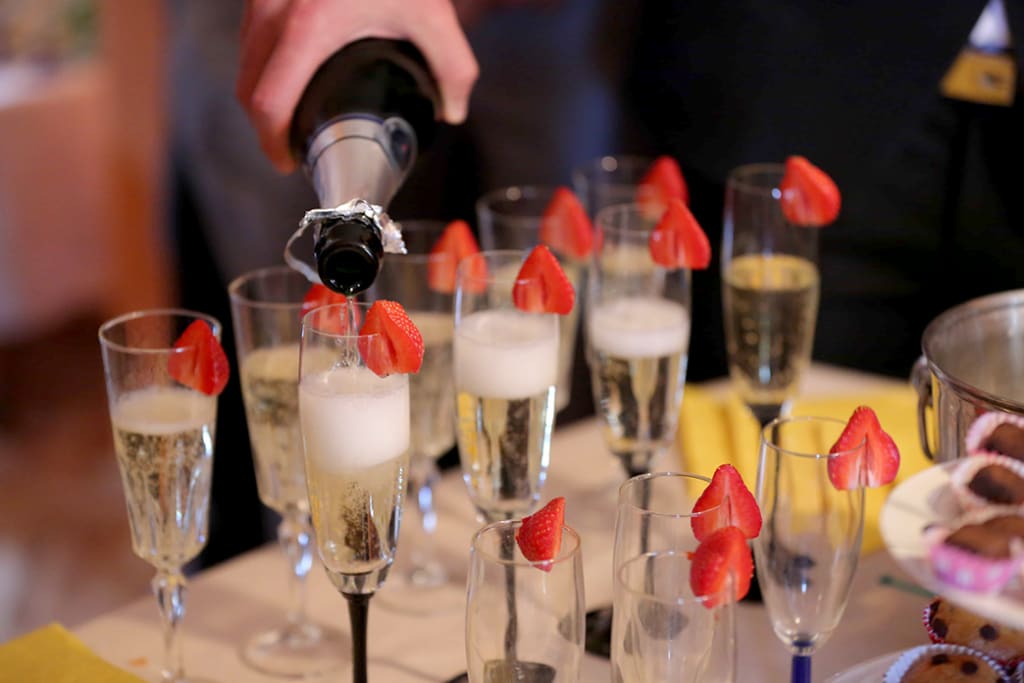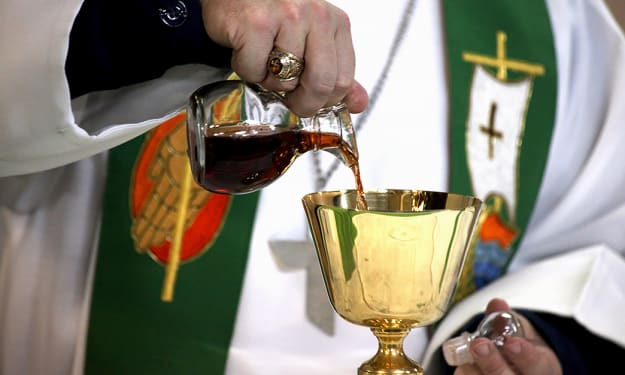Champagne and sparkling wine
What's in the name, and what is in the wine?

What’s in a name? In the case of Champagne, a bubbly brouhaha.
By international agreement, Champagne is produced exclusively in France’s 76,000-acre—132 square-mile—Champagne region using one specific method—méthode champenoise, also known as traditional method.
Only France? Aren’t there American champagnes? Well, yes. And thereby hangs a peculiar tale. By quirk of U.S. law and international peace treaties, some American winemakers legally describe their sparkling wine as “champagne.”
The 1891 Treaty of Madrid reserved “Champagne” exclusively for wines made in Champagne using méthode champenoise. The Treaty of Versailles ending World War I affirmed French rights, but the U.S. never ratified the Treaty of Versailles, creating a legal loophole American winemakers jumped through after repeal of Prohibition in 1933.
Almost all nation’s recognize France’s exclusive right to the Champagne name. The U.S. does partially—any U.S. winemaker who used “champagne” on their label before 2006 as a generic sparkling wine name may continue, but no one else. So some U.S. makers legally make “champagne” thanks to the vicissitudes of the conclusion of World War I.
Other nations use their own names for their sparkling wines:
• France: Crémant (when produced outside the Champagne region)
• Spain: Cava
• Germany: Sekt
• South Africa: Cap Classique
• Italy: Frizzante, Spumante. When made from moscato bianco grapes—Asti Spumante (now usually just Asti) and Moscato d’Asti. Also Lambrusco (from Emilia Romagna region) and Franciacorta (from Lombardy).
Most use a method in which yeast and sugar are added to evoke a second fermentation in the bottle (sealed using a closure similar to a beer bottle cap). After one-to-three years, dead yeast is frozen in the bottle’s neck, removed, and the bottle corked to preserve carbonation.
Voilá, “Champagne” (if you did this in the Champagne region of France). “Sparkling wines” or their regional names are made using the traditional method elsewhere, but not all sparkling wine is made using the traditional method. Hey, this is wine, of course it is not simple and straightforward.
Less expensive sparkling wines get their second fermentation in stainless steel tanks (Charmat process, also called the “tank method,” especially in Italy). This process can mean shorter-lived bubbles, but still can produce excellent sparkling wine, and sparkling wine at a lower price point than Champagne or other wine made using the more labor-intensive fermentation-in-the-bottle method.
The Charmat method originally was created and patented by Federico Martinotti, an Italian, in 1895. French inventor Eugène Charmat improved and patented the method in 1907, and he gives us the name today. In Italy, it sometimes is still called the Metodo Martinotti. It also is called “tank method,” “bulk method,” and “cuve close.” Hey, again, this is the wine world.
The cheapest sparkling wines are made by injecting carbon dioxide into wine, a process similar to how soda pop gets carbonated. Wines made this way are gentler on your wallet, rougher on your palate.
Famille Perrin, a major maker in Provence and the Southern Rhône, recently introduced another method—methode contemporaine. In their new system, the CO2 naturally produced during fermentation is captured, cleaned, compressed, and stored. The CO2 is reintroduced to the wine when it is bottled. The result is a sparkling wine more similar to traditional method wine than it is to the cheap wine with industrial CO2 pumped in.
Champagne methods and sweetness levels
Champagne and sparkling wines made using méthode champenoise get their fizz from the second fermentation in the bottle.
Each bottle holds a secret that makes it distinctive. After a year in bottle—three or more years for premiums—yeast of the second fermentation is frozen in the bottle’s neck and removed (a process called “disgorgement”). Then “dosage”—a mix of sugar, wine, sometimes brandy—is added and the bottle corked. The dosage varies from maker to maker and often is a closely-held secret. Dosage ingredients influence wine’s color and taste. The amount of sugar determines sweetness, described by specific names:
• Brut Natural or Brut Zéro (less than 2.25 grams sugar per 750 ml bottle; least sweet, driest wine)
• Extra Brut (less than 4.5 grams sugar)
• Brut (less than 11.25 grams sugar)
• Extra Sec or Extra Dry (9 to 15 grams sugar)
• Sec (12.75 to 26.25 grams sugar)
• Demi-Sec (24.75 to 37.5 grams sugar)
• Doux (more than 37.5 grams sugar; sweetest wines)
Brut is most common sweetness today; 19th and early 20th century tipplers favored sweeter.
Interesting Champagne facts
• The name “Champagne” likely derives from the Latin word Campania [Land of Plains]. Mentions appear in chronicles from the early 500s CE. Champagne is mostly flat plains, low hills, and the Marne River.
• In addition to the early Latin reference, the dominant population of Celtic origin suggests the name derives from their Celtic language. Kann pan [White Country] references the limestone escarpments (côtes) and the white chalk found throughout the region, into which miles of cellars have been dug. The chalk terroir also influences the distinctive taste of Champagne.
• Today’s boundaries of the Champagne region were established by legislation in 1927.
• Reims is the biggest city and the capital of Champagne. It is 90 minutes by car and 45 minutes by train from Paris.
• The region encompasses 319 villages, also called “crus.”
• There are almost 280,000 wine grape plots in Champagne, tended by more than 16,000 growers. While major makers may own their own vineyards, all buy some or a majority of their grapes from the independent growers.
• Maison Ruinart was the first Champagne-producing company, established by Nicolas Ruinart in 1729. Today, the house is a brand of LVMH Moët Hennessy Louis Vuitton.
• Other major brands and the year of founding include: Taittinger (1734), Moët & Chandon (1743), Veuve Clicquot Ponsardin (1772), Louis Roederer (1776), Heidsieck & Co Monopole and Piper-Heidsieck (1785), Laurent-Perrier (1812), Mumm (1827), Bollinger (1829).
• The Champagne province is located along the 49th parallel, near the northern limit of wine production. The region’s high altitude and mean annual temperature create a challenge for grapes to fully ripen, but the nearby presence of forests, particularly the Ardennes, help mitigate the temperature and help the soil retain moisture. The cool temperatures engender high levels of acidity, a key to Champagne.
• Pinot noir is the most planted grape in Champagne, followed by chardonnay and pinot meunier. These are the three grape varieties most closely associated with Champagne.
• Pinot noir is the most planted grape in the Aube region of Champagne and does well in Montagne de Reims. The Côte des Blancs is planted almost exclusively in chardonnay. Pinot meunier is the dominant grape in the Vallée de la Marne.
Last round humor
• Drink wine, feel fine. Drink beer, feel cheer. Drink Champagne, feel no pain. Drink water… err, nothing really rhymes with water. Let’s go back to Champagne.
• Gluten free. Dairy free. Fat free. You gotta love the Champagne diet.
• One more drink of Champagne and I will be under the influence. Two more drinks of Champagne and I will be under the host.—Adapted from Mae West.
• I drink Champagne when I am in love because it enhances everything. And I drink Champagne when I am not in love to tide me over until I am in love again. As you can see, my true love is Champagne. If I do not have Champagne, any wine will tide me over until I get more Champagne.
• A chicken farmer went to a local wine bar, sat next to a woman and ordered a flute of Champagne.
The woman perked up and said, “How about that? I just ordered a flute of Champagne, too!”
“What a coincidence,” the farmer said. “This is a special day for me. I am celebrating.”
“This is a special day for me too! I am celebrating,” the woman said.
“What a coincidence!” said the farmer. As they clinked flutes, he added, “What are you celebrating?”
“My husband and I have been trying to have a child, and today my gynecologist told me I am pregnant!”
“What a coincidence!” the man said. “I’m a chicken farmer, and for months my hens have been infertile, but today they are all laying fertilized eggs.”
“That’s great!” said the woman, “How did your chickens become fertile?”
“I used a different rooster,” he replied.
“What a coincidence!” the woman said as they clinked flutes.
Contact information
Email: [email protected].
Newsletter: gusclemens.substack.com.
Website: gusclemensonwine.com.
Facebook: Gus Clemens on Wine.
Twitter: @gusclemens
About the Creator
Gus Clemens
Nationally-syndicated humorist/wine writer. Gus appears in Gannett USA Today newspapers and several online platforms. Writing professionally since 1969, Gus has authored or participated in 20 books in addition to his humor/wine work.
Reader insights
Outstanding
Excellent work. Looking forward to reading more!
Top insight
Eye opening
Niche topic & fresh perspectives







Comments (7)
Loved the facts, history, and humor!!! Congratulations on Top Story!!!♥️♥️💕
Hi we are featuring your excellent Top Story in our Community Adventure Thread in The Vocal Social Society on Facebook and would love for you to join us there
Congrats on Top Story!🥳
A very interesting read. Champagne is the only alcohol I drink, it doesn't make me feel sick, but only the real stuff!
Great info! I found Prosecco and Cava tastes just as good as champagne at 10% of the cost. Thanks for explaining all the differences in how they are produced.
♥️♥️♥️♥️♥️♥️♥️♥️♥️♥️explore my stories :https://vocal.media/futurism/navigating-the-ai-revolution-embracing-change-for-better-work
. Superior effort! Keep the outstanding work—congrats